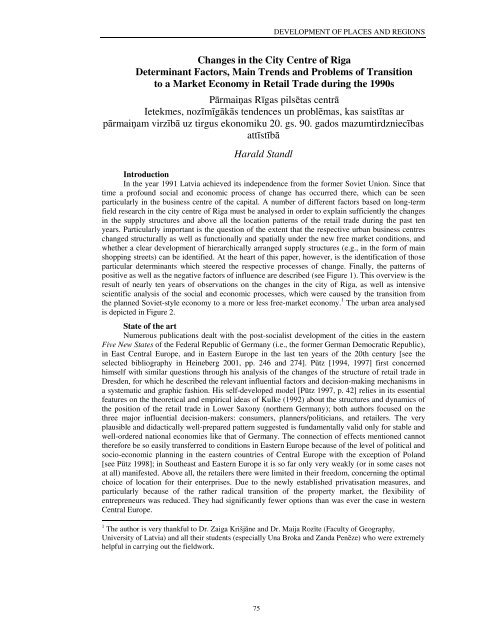Folia Geographica 10. sÄjums - Latvijas UniversitÄte
Folia Geographica 10. sÄjums - Latvijas UniversitÄte
Folia Geographica 10. sÄjums - Latvijas UniversitÄte
Create successful ePaper yourself
Turn your PDF publications into a flip-book with our unique Google optimized e-Paper software.
DEVELOPMENT OF PLACES AND REGIONSChanges in the City Centre of RigaDeterminant Factors, Main Trends and Problems of Transitionto a Market Economy in Retail Trade during the 1990sPārmaiņas Rīgas pilsētas centrāIetekmes, nozīmīgākās tendences un problēmas, kas saistītas arpārmaiņam virzībā uz tirgus ekonomiku 20. gs. 90. gados mazumtirdzniecībasattīstībāHarald StandlIntroductionIn the year 1991 Latvia achieved its independence from the former Soviet Union. Since thattime a profound social and economic process of change has occurred there, which can be seenparticularly in the business centre of the capital. A number of different factors based on long-termfield research in the city centre of Riga must be analysed in order to explain sufficiently the changesin the supply structures and above all the location patterns of the retail trade during the past tenyears. Particularly important is the question of the extent that the respective urban business centreschanged structurally as well as functionally and spatially under the new free market conditions, andwhether a clear development of hierarchically arranged supply structures (e.g., in the form of mainshopping streets) can be identified. At the heart of this paper, however, is the identification of thoseparticular determinants which steered the respective processes of change. Finally, the patterns ofpositive as well as the negative factors of influence are described (see Figure 1). This overview is theresult of nearly ten years of observations on the changes in the city of Riga, as well as intensivescientific analysis of the social and economic processes, which were caused by the transition fromthe planned Soviet-style economy to a more or less free-market economy. 1 The urban area analysedis depicted in Figure 2.State of the artNumerous publications dealt with the post-socialist development of the cities in the easternFive New States of the Federal Republic of Germany (i.e., the former German Democratic Republic),in East Central Europe, and in Eastern Europe in the last ten years of the 20th century [see theselected bibliography in Heineberg 2001, pp. 246 and 274]. Pütz [1994, 1997] first concernedhimself with similar questions through his analysis of the changes of the structure of retail trade inDresden, for which he described the relevant influential factors and decision-making mechanisms ina systematic and graphic fashion. His self-developed model [Pütz 1997, p. 42] relies in its essentialfeatures on the theoretical and empirical ideas of Kulke (1992) about the structures and dynamics ofthe position of the retail trade in Lower Saxony (northern Germany); both authors focused on thethree major influential decision-makers: consumers, planners/politicians, and retailers. The veryplausible and didactically well-prepared pattern suggested is fundamentally valid only for stable andwell-ordered national economies like that of Germany. The connection of effects mentioned cannottherefore be so easily transferred to conditions in Eastern Europe because of the level of political andsocio-economic planning in the eastern countries of Central Europe with the exception of Poland[see Pütz 1998]; in Southeast and Eastern Europe it is so far only very weakly (or in some cases notat all) manifested. Above all, the retailers there were limited in their freedom, concerning the optimalchoice of location for their enterprises. Due to the newly established privatisation measures, andparticularly because of the rather radical transition of the property market, the flexibility ofentrepreneurs was reduced. They had significantly fewer options than was ever the case in westernCentral Europe.1 The author is very thankful to Dr. Zaiga Krišjāne and Dr. Maija Rozīte (Faculty of Geography,University of Latvia) and all their students (especially Una Broka and Zanda Penēze) who were extremelyhelpful in carrying out the fieldwork.75
















